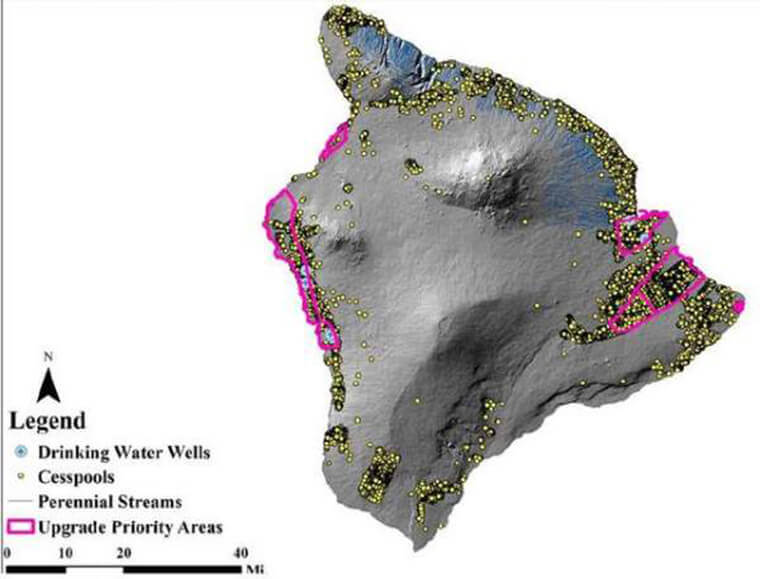Puako Road-County and State Team Up

(Hawaii Department of Health/Courtesy graphic)
County and State team up to tackle effluent issues on Big Island including Puako Road area near Mauna Lani Resort
Many of my friends make a living in the dive industry and most of the great dive sites are located adjacent and just off shore of Puako Road. When they reported the beaches along Puako Road were closed by the Hawaii County Health department due to high levels of waste water bacteria, I was not surprised. Having spent time as development director at the Big Island Country Club site, where aerobic pre treatment was mandated due to the developable lots and golf course comfort stations being located in close proximity to the potable water wells, I knew the Puako area was in need of similar, advanced, waste water treatment being so close to the ocean.
Many of the homes along this scenic road were built as far back as the 1930’s and modern waste water treatment was not facilitated or known. Since then the area has been regentrified where these basic homes have been replaced with modern structures and typical septic tank systems installed that feature aerobic pre treatment tanks that help to insure proper treatment. That being said, there are plenty of older “cottages” that still use cess pools with no advanced treatment.
The Puako area is low lying where many of the properties have brackish ponds that lead out to the open ocean indirectly through lava tubes and porous soils making the effective treatment of waste water critical. Read the very informative article here or click the link for more details. Let’s hope more property owners that have cess pools decide to convert to aerobic systems sooner than later!!
Article in West Hawaii Today
Direct link: http://westhawaiitoday.com/news/local-news/county-state-team-tackle-effluent-issues-big-island
County, state team up to tackle effluent issues on Big Island
Published December 28, 2017 – 12:06am
By Nancy Cook Lauer West Hawaii Today ncook-lauer@westhawaiitoday.comHILO — Five Big Island regions are especially vulnerable to contamination from cesspools, a state report says.
The Dec. 19 report to the Legislature by the Department of Health says the Big Island is home to more than half of the state’s 87,900 cesspools, and has five of the 14 areas prioritized for cleanup.
In all, Hawaii Island’s 49,300 cesspools discharge 27.3 million gallons of effluent per day, the report says.
It lists Puako, with 150 cesspools, and the Alii Drive area of Kona, with 6,500 cesspools, as well as Hilo Bay, with 8,700 cesspools, Keaau, with 9,300 cesspools, and Kapoho, with 220 cesspools, as priority areas. There are no priority level 1 areas on Hawaii Island, and only Keaau is a priority level 2. The remainder are level 3.
Priority 1 areas present significant risk of human health impacts, drinking water impacts or draining to sensitive waters. Priority 2 areas have potential to impact drinking water and priority 3 areas have potential to impact sensitive waters.
Another 24,430 cesspools on Hawaii Island require data review and prioritization, according to the report.
It’s an expensive problem.
The cost to upgrade all of the state’s roughly 88,000 cesspools is estimated at $1.75 billion. State law currently requires the elimination of cesspools in Hawaii by year 2050.
Puako homeowners, for example, would face monthly bills of $200-$800 for 20 to 30 years, just for their system alone. Only 30 percent of Hilo property owners are connected to a sewer system.
“This is going to cost a lot of money to fix,” county Environmental Management Director Bill Kucharski said Wednesday. “There’s really no choice. The ocean is our breadbasket. We need to protect it.”
He said the county has applied through the state for an Environmental Protection Agency Clean Water grant of about $300,000 to get a handle on the county’s worst areas.
Increases in sewer rates for those on the county system are also being contemplated.
Kucharski said the county hopes to find less expensive alternatives to comprehensive sewer systems around the island.
The 36-page report (http://bit.ly/2C0Czm2) defines problems in key areas, but offers little in the way of solutions, other than a pledge to “continue to work with communities, their respective legislative and county representatives, state and county agencies, and stakeholder groups to receive input on, and discuss possible solutions to, the problems identified in this report.”
Last year, Gov. David Ige signed a bill banning new cesspools statewide.
In 2015, Ige signed Act 120, which gives $10,000 income tax credits for homeowners in areas near water sources to upgrade their cesspools to more effective wastewater treatment systems. The credit program runs though Dec. 31, 2020.
So far, only 47 applications have been processed, according to the report. The program is limited to a total of $5 million or about 500 cesspool upgrades per year. Under the law, owners of cesspools located within 500 feet of the ocean, streams or marsh areas, or near drinking water sources can qualify for the tax credit.
“The state began taking action last year, and today’s report clearly highlights the need for greater measures to tackle this impending threat to our drinking and recreational waters,” Keith Kawaoka, DOH deputy director of the Environmental Health Administration, said in a statement. “With 88,000 systems currently affecting our environment, it will take a concerted effort by our entire community to convert existing systems to safer alternatives.”
Generally, options for upgrade or closure include closure and connection to an existing nearby sewer system with available capacity, closure and connection to a new private or public sewer system, closure and connection to a community-scale package wastewater treatment system or upgrade to an on-site septic tank and/or aerobic treatment unit system.




